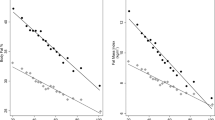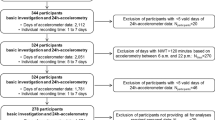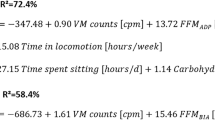Abstract
OBJECTIVE: To determine the relation between the average daily physical activity level (PAL) and the trajectory of weight change in men at risk for weight gain.
DESIGN AND SETTING: Clinic-based cohort study over an average of 5 y.
SUBJECTS: Healthy men (N=2501) ages 20–55 y participating in the Aerobics Center Longitudinal Study who had received at least four medical examinations at the Cooper Clinic between 1970 and 1998.
MEASUREMENTS: Daily leisure-time physical activity was reported and body weight was measured at all four examinations. The average daily PAL (METs 24 h−1) was estimated from all activities, as well as from other incidental active and passive activities. Weight change over four examinations was regressed on the change in PAL between the first and third examinations.
RESULTS: Random coefficient regression modeling indicated a curvilinear slope for weight gain over the follow-up among those maintaining the same PAL between the first and third examinations. Weight gain was further accelerated among men who decreased their activity. A shift from a low PAL (<1.45 METs 24 h−1) to a moderate (1.45–1.60 METs 24 h−1) or high (>1.60 METs 24 h−1) PAL was necessary for weight loss over time. Men with initially the lowest PAL had the greatest benefit from increasing activity.
CONCLUSIONS: Daily PAL was inversely related to weight gain in this cohort. Increasing to or maintaining a daily PAL at least 60% above the resting metabolic rate (ie, PAL >1.60 METs 24 h−1) may be necessary to maintain body weight in middle-age and can be achieved by incorporating 45–60 min of brisk walking, gardening/yardwork, or cycling into the daily routine.
This is a preview of subscription content, access via your institution
Access options
Subscribe to this journal
Receive 12 print issues and online access
$259.00 per year
only $21.58 per issue
Buy this article
- Purchase on Springer Link
- Instant access to full article PDF
Prices may be subject to local taxes which are calculated during checkout




Similar content being viewed by others
References
Flegal KM, Carroll MD, Ogden CL, Johnson CL . Prevalence and trends in obesity among US adults, 1999–2000. JAMA 2002; 288: 1723–1727.
Seidell JC, Verschuren WMM, Kromhout D . Levels and trends in obesity in The Netherlands, 1987–1991. Int J Obes Relat Metab Disord 1995; 19: 924–927.
Sundquist K, Qvist J, Johansson S-E, Sundquist J . Increasing trends of obesity in Sweden between 1996/97 and 2000/01. Int J Obes Relat Metab Disord 2004; 28: 254–261.
Cordain L, Gotshall RW, Eaton SB . Physical activity, energy expenditure and fitness: an evolutionary prospective. Int J Sports Med 1998; 19: 328–335.
Hill JO, Wyatt HR, Reed GW, Peters JC . Obesity and the environment: where do we go from here? Science 2004; 299: 853–855.
DiPietro L . Physical activity, body weight, and adiposity: an epidemiologic perspective. In Holloszy JO (ed.). Exercise and Sport Science Review, Vol. 23, Williams & Wilkins: Baltimore, MD; 1995; 23: 275–303.
Prentice AM, Jebb SA . Obesity in Britain: gluttony or sloth. BMJ 1995; 311: 437–439.
DiPietro L, Kohl III HW, Barlow CE, Blair SN . Improvements in cardiovascular fitness attenuate age-related weight gain in healthy men and women: The Aerobics Center Longitudinal Study. Int J Obes Relat Metab Disord 1998; 22: 55–62.
Lewis CE, Smith BE, Wallace OD, Williams OD, Bild DE, Jacobs Jr DR . Seven year trends in body weight and associations of weight change with lifestyle and behavioral characteristics in black and white young adults: The CARDIA Study. Am J Public Health 1997; 87: 635–642.
Wier LT, Ayers GW, Jackson AS, Rossum AC, Carlos Poston WS, Foreyt JP . Determining the amount of physical activity needed for long-term weight control. Int J Obes Relat Metab Disord 2001; 25: 613–621.
Westerterp KR . Obesity and physical activity. Int J Obes Relat Metab Disord 1999; 23: 59–64.
World Health Organization. Obesity. Preventing and Managing the Global Epidemic. World Health Organization: Geneva, Switzerland; 1998.
Schoeller DA, Shay K, Kushner RF . How much physical activity is needed to minimize weight gain in previously obese women? Am J Clin Nutr 1997; 66: 551–556.
Blair SN, Kohl III HW, Paffenbarger Jr RS, Clark DG, Cooper KH, Gibbons LW . Physical fitness and all-cause mortality: a prospective study of healthy men and women. JAMA 1989; 262: 2392–2401.
Ainsworth BE, Haskell WL, Leon AS, Jacobs Jr DR, Montoye HJ, Sallis JF, Paffenbarger Jr RS . Compendium of physical activities: classification of energy costs of human physical activities. Med Sci Sports Exerc 1993; 25: 71–80.
Brown H, Prescott R . Applied Mixed Models in Medicine. John Wiley & Sons, Ltd: Chichester, England; 1999.
US Department of Health and Human Services (PHS). Physical Activity and Health. A Report of the Surgeon General (Executive Summary). Superintendent of Documents, Pittsburgh, PA; 1996.
Saris WH, Blair SN, van Baak MA, Eaton SB, Davies PS, Di Pietro L, Fogelholm M, Rissanen A, Schoeller D, Swinburn B, Tremblay A, Westerterp KR, Wyatt H . How much physical activity is enough to prevent unhealthy weight gain? Outcome of the IASO 1st Stock Conference and consensus statement. Obes Rev 2003; 4: 101–114.
Acknowledgements
This research was supported in part by grants from the National Institutes of Health, National Institute of Aging (AG-06945 and AG-17163). We thank Dr. Kenneth H. Cooper for conceptualizing and initiating the Aerobics Center Longitudinal Study, the Cooper Clinic physicians and technicians for collecting the laboratory data, Carolyn E. Wright and the data management staff at the Cooper Institute for data management support, Dr. Marilu Meredith and Margo Simmons for managing the data entry process, and James Hill, PhD, for his thoughtful contributions to this manuscript.
Author information
Authors and Affiliations
Corresponding author
Rights and permissions
About this article
Cite this article
Di Pietro, L., Dziura, J. & Blair, S. Estimated change in physical activity level (PAL) and prediction of 5-year weight change in men: the Aerobics Center Longitudinal Study. Int J Obes 28, 1541–1547 (2004). https://doi.org/10.1038/sj.ijo.0802821
Received:
Revised:
Accepted:
Published:
Issue Date:
DOI: https://doi.org/10.1038/sj.ijo.0802821
Keywords
This article is cited by
-
Longitudinal association between body mass index and physical activity among adolescents with different parental risk: a parallel latent growth curve modeling approach
International Journal of Behavioral Nutrition and Physical Activity (2020)
-
Trajectories of the relationships of physical activity with body composition changes in older men: the MrOS study
BMC Geriatrics (2017)
-
Long-term health benefits of physical activity – a systematic review of longitudinal studies
BMC Public Health (2013)
-
Changes in occupational class differences in leisure-time physical activity: a follow-up study
International Journal of Behavioral Nutrition and Physical Activity (2011)
-
Muscular Strength Is Inversely Related to Prevalence and Incidence of Obesity in Adult Men
Obesity (2010)



